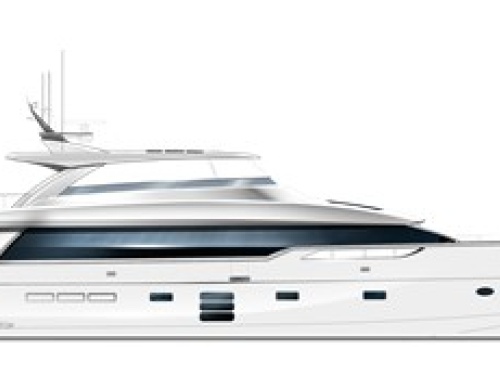Access More Boat Tests
Already have an account? Login
Hatteras M90 Panacera (2018-)
2 x 1902-hp CAT C-32A
Price
See the price by becoming
a BoatTEST member.
Members Must Log In
Brief Summary
The name “Panacera” was chosen to reflect this new yachts open floor plan and stunning panoramic views. It’s available in an open or enclosed flybridge arrangement and both provide excellent entertainment venues. She has four en suite staterooms, including a full beam master. There are crew quarters for four. A particularly noteworthy option, and a first for Hatteras, is her side balcony that flips down from the bulwarks. Fronted by glass doors, it’s a stunning addition. But for all her looks and functionality, she’s among the most technically advanced yachts Hatteras has produced, and in our opinion, making ease of operation among the forefront of her many advantages.
Key Features
- Resin-infused bulkheads and interior decks using crosslinked foam core
- Handcrafted European Walnut with satin finish interior
- Fiberglass gray water tanks with sewage pump, plumbed for dockside pump-out
- Two 24V banks of heavy-duty, 12V marine batteries mounted in fire retardant fiberglass boxes
- Integrated camera system
- Electric power steering with programable differential steering, turn angles, rate of turn, and helm resistance
- King size sunpad with cover, integrated into the superstructure
- Home Theater Entertainment system
Test Results
| RPM | MPH | Knots | GPH | MPG | NMPG | STAT. MILE | NM | dBa |
|---|---|---|---|---|---|---|---|---|
| 650 | 6.9 | 6 | 7 | 1 | 0.9 | 2914 | 2534.1 | 63 |
| 1000 | 11.1 | 9.6 | 21.5 | 0.5 | 0.4 | 1520 | 1321.3 | 65 |
| 1250 | 11.5 | 10 | 39 | 0.3 | 0.3 | 872 | 758.1 | 67 |
| 1500 | 11.7 | 10.2 | 73 | 0.2 | 0.1 | 474 | 412 | 71 |
| 1750 | 17.5 | 15.2 | 109.5 | 0.2 | 0.1 | 473 | 410.9 | 76 |
| 2000 | 23.3 | 20.2 | 151.5 | 0.2 | 0.1 | 454 | 394.5 | 78 |
| 2100 | 25.2 | 21.9 | 169 | 0.1 | 0.1 | 440 | 382.6 | 78 |
| 2250 | 27.4 | 23.8 | 191.5 | 0.1 | 0.1 | 423 | 367.8 | 80 |
| 2315 | 28.4 | 24.7 | 205.5 | 0.1 | 0.1 | 409 | 355.3 | 80 |

Specifications
| Length Overall | 91' 9" / 27.95 m |
|---|---|
| Beam |
22 '6" 6.86 m |
| Dry Weight |
230,000 lbs. 104,326 kg |
| Tested Weight |
254,236 lbs. 115,319 kg |
| Draft |
6' 2" 1.88 m |
| Deadrise/Transom | N/A |
| Max Headroom | N/A |
| Bridge Clearance | N/A |
| Weight Capacity | N/A |
| Person Capacity | N/A |
| Fuel Capacity |
3,285 gal. 12,435 L |
| Water Capacity |
820 gal. 3,104 L |
| Total Weight |
254,236 lbs. 115,319 kg |
Acceleration Times & Conditions
| Time to Plane | 10.6 sec. |
|---|---|
| 0 to 30 | 55.2 sec. (0to20) |
| Ratio | 3.93:1 |
| Props | 54” x 66” pitch 8 blade |
| Load | 4 persons, 8/9 fuel, 7/8 water, 50 lbs. of gear |
| Climate | 78 deg., 65 humid.; wind: 0-5 mph; seas: calm |
Engine Options
| Tested Engine |
2 x 1902-hp CAT C-32A |
|---|---|
| Std. Power |
2 x 1600-hp Cat C-32A |
| Opt. Power |
Not Available |
Contents of Report

Mission
The Hatteras M90 Panacera was designed to be a world-class long range cruiser, capable of making bluewater passages in comfort for her owners and guests. Her 22’6” (6.86 m) beam, 230,000 lbs. (105,545 kg) of dry displacement, and stabilizers, ensure one of the best offshore rides in class. With four en suite staterooms, a huge flying bridge and entertaining venues all over the boat, she can handle a crowd for cocktails or formal dining.




Overview
When we compare the Hatteras M90 Panacera with six other major brands of flybridge motoryachts in the size range, we discovered that the M90 Panacera exceeds the others in virtually all important specifications. The reason for that is this boat is intended to be the real thing -- a long range cruising motoryacht that not only looks the part of a world cruiser, but has the build to carry out the mission -- all under a sophisticated, modernistic light and airy design and décor that artfully covers the beast below.
It All Starts with the Basic Specs. At 22’6” (6.86 m), she is the beamiest boat among those that we checked. At 230,000 lbs. (104,545 kg), she by far has the greatest displacement. She can also carry the greatest load of fuel at 3,285 gallons (12,435 L) and water at 820 gallons (3,104 L), the latter number is nearly twice that of several boats in class.
Functionality. Further, the trend to large motoryachts is now at least its third decade and there are plenty of owners in the market who fully understand the importance of functionality. They appreciate dependable installation and equipment, redundancy, and practical design. They also appreciate state-of-the-art systems and in the M90 Panacera, Hatteras introduces one of the most remarkable total control systems where have ever seen.

Operations: Total Ship Control
HattCON
Probably the most significant operations feature of the Hatteras M90 Panacera is the HattCON system. We’ve seen touchscreen interface systems before and for the most part, they allow controllability of the lights, heat and air… etc., all from a touchscreen or two, or an iPad Mini.
But HattCON goes a giant leap further. While we still have that same controllability, HattCON also integrates, among other things, the bridge systems into the game.

Systems Integration
Say we have a radar from Furuno, a Garmin GPS, a RayMarine autopilot…etc. Well each one of these components will have its own user-interface to learn and remember. Think about it… just a simple display change is different from one manufacturer to another.
The Tyranny of Software Geeks. Want your orientation to be heading up instead of north up? Let’s see…. Menu, display, ummm, nope, back, menu, chart, chart display…. Nope, back… back, chart options, orientation…ah there it is. And on and on like that. It’s like they never use their own equipment and don’t care that the menu items are so hard to interpret and figure out.
The Hatteras Solution. HattConn, on the other hand, takes all those systems and combines them into one easy to use and understand unit… all with the same user interface. Everything works the same, regardless of the manufacturer, and the best part, it’s all intuitive. Whatever you want to do will typically be no more than two button presses away from any screen.
This is remarkable.

Built-in Safety
But wait, there’s more. With HattCON controlling everything, we also have built-in fail-safes in the system. For example, press HattCON (which is essentially the Home Screen) and go to nav lights. We then touch the “ON” button…. and nothing happens. The system is designed, by default, to require a positive touch, or in other words a press and hold, to turn the lights on.
A scroll bar moves while holding to show that it’s working and we can program how long we need to hold to make it work…. A little, a lot, or not at all, your choice.
Limiting Access for Safety. Another cool safety feature is that while there are iPad Mini’s all around the boat, there are separate profiles, and only the captain gets one with unlimited access. That way, little Johnny can’t start altering the course on the autopilot, or discharge the holding tanks while tied to the dock.
Even the steering is programmable. On our test boat, the steering is three turns from lock-to-lock while around the dock. Underway, it’s five turns.

Lights Please
Back to the subject of lights, naturally all the vessel lighting is controlled through this system, no shocker there. But do we really want someone on the bridge shutting off the lights in the VIP stateroom? What if someone is there? Well, the system recognizes where the controllers are and prevents anyone from shutting off the lights in any room that they’re not in. This way, no person onboard is suddenly, and unexpectedly, plunged into darkness.
If we really, really, want all the lights off, then yes, there’s an override code that can be inputted to allow the captain to do what he/she wants. And that code is user programmable.
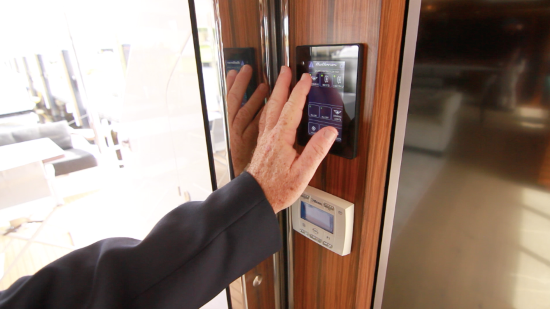
Keeping it Simple. As for each room, sure the iPad can turn the lights on, but instead, Hatteras put a small screen just inside the door of every room so that we can turn the lights on as if we were flipping a switch in the normal fashion. But instead of a flip, it’s a press on a backlit screen with several “switches” for things like lights, temperature, and the ability to raise and lower the blinds.

Anti-Theft and Misuse Device
This system is so smart that it also includes a fingerprint identification system to activate the ignition. No keys to turn, just scan your fingerprint and press the start buttons. If you’re not one of the ones programmed into the system, then you’re not starting the boat.
And just like the lights, there’s an override code that the knowledgeable captain can input to still start the yacht if the fingerprint system fails (wet fingers, Band-Aids….etc.). And because it’s military-grade, we can program up to 100 users. Not that you’d want to, but you can.

Essentials are Still Accessible the Old-fashioned Way. Of course, that is not to say that HattCON has eliminated every button from the yacht. No, some things you still want quick access to. The horn certainly comes to mind, but in addition, the helm panel is also populated with buttons for nav lights, bilge pumps, spot light… etc. Things we don’t want to hunt for from any interface system, no matter how user-friendly.
This system is much more involved than what we’re describing here. In fact, it could use its own full report. But this gives the gist of the system and suffice it to say that the more we used it, the more impressed we were with it.

The system is also paired with the premium audio/visual system with Crestron automation and Integrated Digital Storage ($163,630) that definitely raises the bar for the entertainment aspects of the 90 Panacera.
HattCON Systems Summary
Helm Ship Management:
• Four multi-function touch helm displays
• Surface mounted display foil with integrated controls
• Finger print reader ignition protection with digital passcode backup
Integrated Camera system:
• Night Vision Camera
• Pan Tilt Zoom engine room camera
• Dual Pan Tilt Zoom aft deck cameras
Navigation and Systems Management:
- • Including navigation, radar, chart, sounders, and autopilot
- • Electric power steering alarm monitor
- • Rudder angle indicator
- • Synchronized console illumination
- • Hydraulic system controls integration
- • Navigation lights control and monitoring
- • Light controls, interior, and exterior
- • Lumishore underwater light integration
- • Chiller controls
- • Watermaker controls
- • Dual VHF radios
Systems Monitoring:
• Bilges
• Smoke, fire, and Co detection
• Tankage levels
• Engine and propulsion data
• Autopilot integration with rudder angle feedback
• Generator data
• AC power
• DC power
• Battery charger
• Door and hatch open alarms
• Fuel tank level gauges at deck fills
Yacht Automation:
Two 10” (25.4 cm) integrated multi-function touch display (Galley and Crew) with controls for lights, HVAC, smart glass control, and access to HattCON full Ship Management and System Monitoring
Wall mounted auto dimming touch screens placed in convenient locations with HattCON App accessible features:
• Interior lights on/off/dim
• HVAC controls, smart glass control, exterior lights
• Lumishore multi-color light control
• Master all-off light switch (password protected) with exit timer
• Motion detection control of low level lights in heads
• Window blinds control (optional)
HattCON iPhone/iPad app fully configurable with dual profiles:
- • Master / Captain profile with access to main system
- • Guest profile with access to guest stateroom light / HVAC control and limited access to main system
The Helm

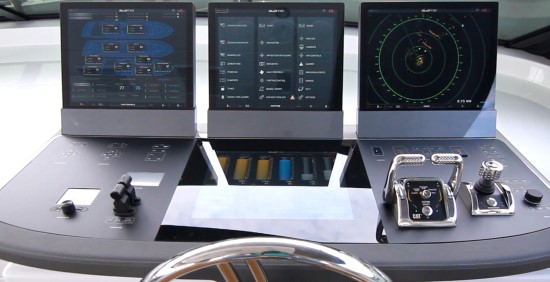


Features Inspection
The Stern


Swim Platform
The swim platform is sizable at 4’3” (1.30 m) for the fixed portion and a 5’4” (1.63 m) hydraulic lift section ($178,816) that has an 1,800-pound (475.51 kg) lift capacity for installing a tender. In the center are integrated stairs so when the platform is lowered the stairs automatically deploy.
In the transom there is a watertight door leading to the crew’s quarters and above that, and to starboard, there’s a hatch to the transom shower. For securing a tender, both corners of the platform are fitted with 6” (15.24 cm) pull-up cleats.

Side Decks
The M90 Panacera has a symmetrical layout so the side decks are the same width on both sides. Just ahead of the aft deck, there are opening side doors. The width of the deck is 19” (48.26 cm) from the cabin sides to the bulwarks that come up 33” (83.82 cm) from the deck.


To the starboard cabin sides at midships, a hatch conceals the Sea Stair side boarding ladder allowing us to enter the side decks just ahead of midships, and adjacent to the watertight doors leading inside. The extended overhead adds protection from the elements and rain is channeled over the side and not onto the deck, or its occupants.

The Bow
At the bow, Hatteras created a comfortable gathering and entertaining area that is sure to be a popular place, especially when underway, thanks to the magnificent viewpoint. It consists of a sun pad running 6’1” (1.85 m) fore and aft, and 8’6” (2.59 m) side to side.
Just behind is opposing seating for up to 10 to either side of a solid wood table on two fixed pedestals. Naturally, there are courtesy lights at deck level and speakers connected to the stereo that is controlled by HattConn. And as expected, there’s storage throughout this area.


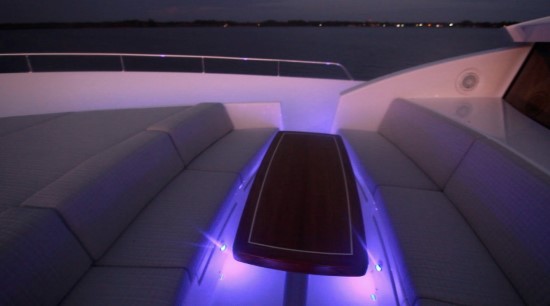


Aft deck
The exterior gatherings continue at the aft deck, and actually, this will likely be the first entertainment space that guests will see as they board the M90 Panacera. The entire area is under the protection of the extended flybridge deck’s 7’1” (2.16 m) overhead. Built-in seating is nestled into the transom, and there is lots of deck space to the sides and inside of the table to place folding deck chairs.
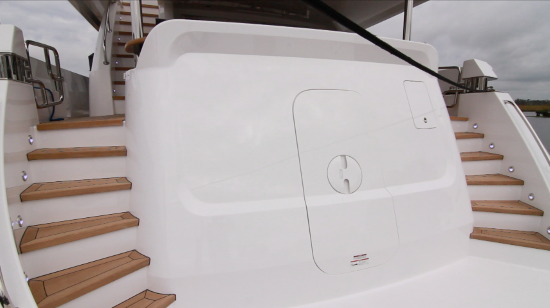
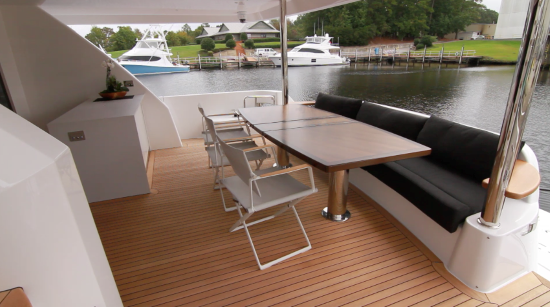


The built-in console has ample counter space and a covered sink. Below is a refrigerator, icemaker, and storage. Overhead is a drop down 40” (101.6 cm) TV ($18,400) controlled through HattConn, along with the stereo connected to speakers throughout the aft deck.
To the port side is access to the crew’s quarters and then the stairs to the flying bridge. Another set of stairs to the flying bridge is inside.
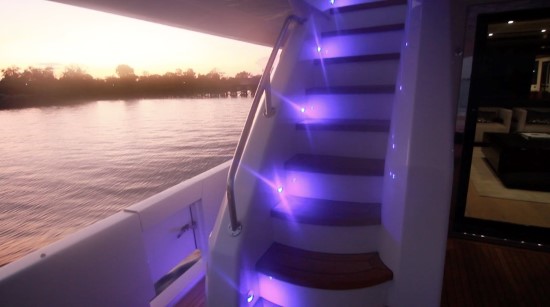
Flying Bridge
The flying bridge is accessed from either an external set of stairs at the aft deck or an internal set to port of the dining room. It’s an open flybridge and Hatteras also builds an enclosed version as an option.


Starting with the aft section, Hatteras creates an open area that can be used as a boat deck or, as on our test boat, an open sunning area. If the boat deck option is chosen, a crane will be fitted that can launch a tender or water toys off the stern or over the side. On our test boat, this owner went with the open plan. Ahead and to port there is a double-burner electric grill with open counter space that we’d like to see equipped with raised edges. Below is a refrigerator and storage compartments.





Forward Flying Bridge
The forward section consists of opposing seating starting with a table to port that seats eight across from a sofa behind a teak table with stainless steel beverage holders. Above the dining table is a drop down 40” (101.6 cm) TV. The decking is teak ($108,233) with a natural finish. Continuing forward, the entertainment continues with two stations flanking a walkthrough to the helm area. To port is open counter with storage underneath. To starboard there’s a sink with more open counter space, and below there’s another refrigerator along with an icemaker.
The hardtop is 6’8" (2.03 m) off the deck and extends partway to cover the forward seating area, which on our test boat was enclosed with roll down isinglass curtains to provide three-season comfort and maintain climate control through the air conditioning system.
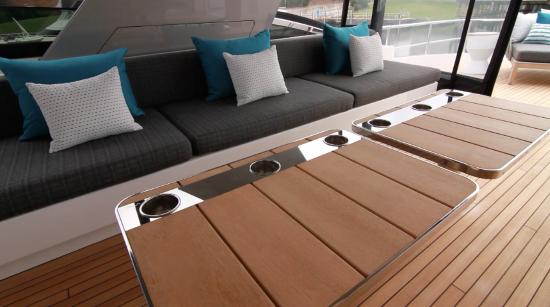


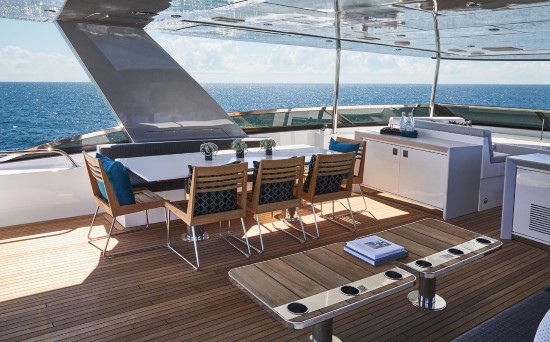
Continuing ahead between these two units, we come to the starboard mounted helm and a port mounted L-shaped seat that allows guests to enjoy the captain’s company and the same view.


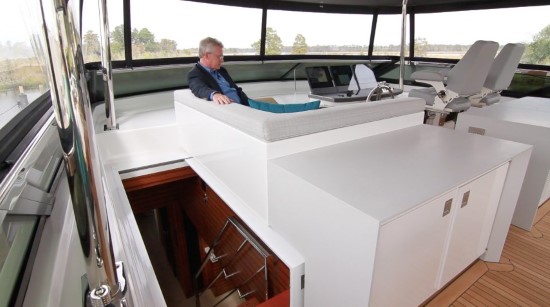


Interior -- General Observations
The interior of the M90 Panacera takes good advantage of its 22’6” (6.86 m) beam to provide plenty of open space that further benefits from the thoughtful design touches of Cullen Moser. It takes a lot of influences from the 70 Motor Yacht with its copious amounts of natural light and tall frameless windows. But the overall look and feel, in terms of the choice of woods in particular, strikes a balance between classically modern but still timeless yachting elegance.
One doesn’t look at this interior and identify it with an era or timeframe. It’s a combination of the characteristics of the 70, and indeed some of Hatteras’ older flushdeck yachts, expertly blended to create this timeless styling.

Less is More. As for the layout, a lot of consideration went into it. The architect Ludwig Mies van der Rohe’s minimalist design and “less is more” concept certainly applies here. Moser was able to maintain the open and airy feel of the M90 Panacera by carefully locating the interior furnishings so that they accommodate all the guests while still providing a roomy flow through the salon, and indeed the entire deck.
Salon
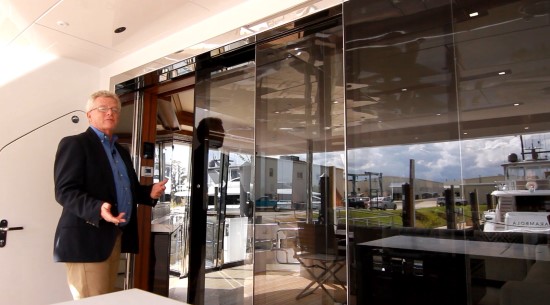
Intelligent Doors. As we move to the interior, we gain access via a set of electrically actuated three-panel sliding glass doors with polished stainless steel frames. The doors will stay open for 5 seconds, plenty of time to allow people to walk through. If we get some late arrivals and the doors start to close, sensors both inside and outside will stop the closing procedure and open them fully again.
Of course, we can lock them open to allow fresh air, plus they can be opened fully across the opening to form one continuous flow from the aft deck.


Light There Be Light…and Vista. The interior design concept was to provide panoramic views out the huge frameless windows, with low sills, and electrically actuated blinds (a la HattCON) completely surrounding the interior spaces. The open and airy feel is enhanced by the 7’ (2.13 m) overhead height, one of the highest in class.
To the aft port corner, there’s a 65” (165.10 cm) flatscreen TV connected to a premium, and we do mean premium, surround sound system. Guests will be comfortably ensconced in the custom designed furniture consisting of a sofa and two individual chairs that are wrapping around a large cocktail table, all to starboard and all over a deck fabricated from engineered White Oak. An area rug separates the seating spaces from the natural path further aft.


To maintain the open feel, and the walkthrough capability, a buffet cabinet was installed to port and moved forward under the floating tread stairway to the flying bridge. It offers plenty of open counter space and underneath, there’s storage, an icemaker, a refrigerator and dedicated storage for leaded crystal.

A Balcony for Romance
The owner of this yacht chose the optional sliding glass doors leading to Hatteras’ debut electrically actuated flip-out balcony ($239,000 with glass doors) that adds a hefty dose of romance to this yacht. It can be installed to port, starboard or both sides if desired.
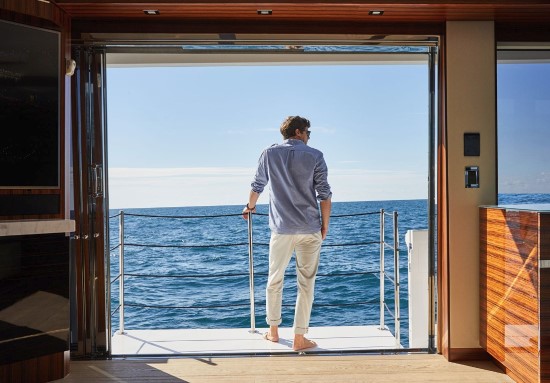


Dining Room
Keeping with the open floor plan, there’s a smooth transition between the salon and the dining area just ahead. In fact, the delineation between the two is more of a subtle feature that draws the eye without occupying space. Looking overhead in the salon we see Rosewood strips housing the LED lights. In the middle of the full length of the overhead is a wider strip that continues down the side bulkhead and it is this that separates the two rooms, all without a wall.
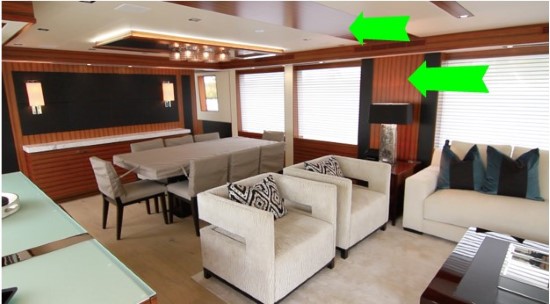
Ahead of the table, another buffet/storage unit is against the forward bulkhead. Along with the ample counter space, the dinnerware stores here in dedicated holders that keep everything secure in a seaway.



The focal piece of the area is, of course, the table that seats eight. Chairs are by Holly Hunt and leather upholstered. Under the table the wood pedestal is open and beveled.
When underway, there are covers for each of the chairs that get attached to the table’s cover. In this manner, the chairs remain secured during passages. Overhead, Rosewood styling continues and frames a mirrored in a soffit with drop lights along with subtle perimeter lights.
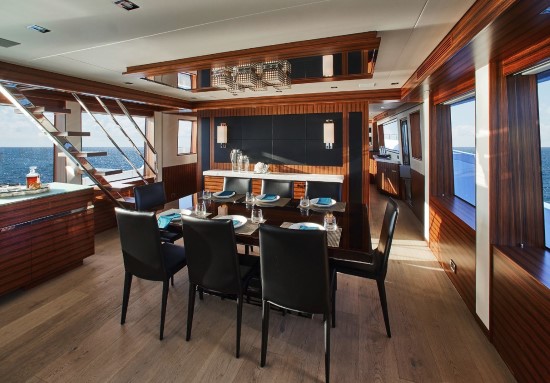

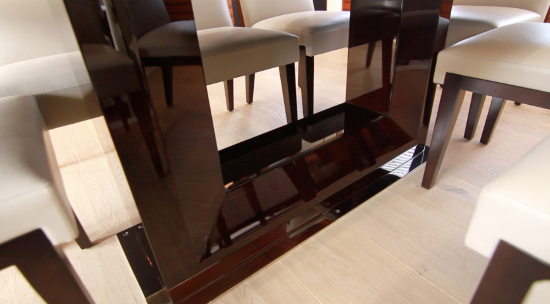

The forward section of the dining room consists of a bulkhead with open passages to both port and starboard leading forward to the galley. The passageway to port has a watertight door to the side deck. The day head is opposite. The passageway to starboard has another watertight door and opposite is the companionway to the lower deck accommodations.
In this way, staff can enter the galley from their quarters aft without disturbing the guests.
Day Head
No yacht this size would be well designed without a day head and the M90 Panacera has one which maintains the modern décor with elegance by having a bulkhead covered in marble. It is located in the port passageway between the dining area and the galley, just opposite the door to the side deck.

Galley
The M90 Panacera galley is fully forward on the main deck and clearly lends itself to having a professional chef onboard because there’s a distinct separation between this cooking area and the rest of the yacht. And to our eye, it’s a professional grade galley.
Europeans, especially, will like this layout. But it has also been carefully designed to be a country kitchen, as well, something that most American will like.

Let There Be Light. But the biggest distinction between this galley and others in class is its massive window and glass treatment that are on three sides plus the huge skylight on the overhead. Since the M90 Panacera has its only helm station on the flying bridge, the chef will also enjoy the outstanding views that the captain normally would have in this forward position.
The entire area is surrounded by windows. Overhead is a massive skylight with Smart Glass that dims to a moonlight shade at the touch of a HattCON Button.


Hatteras installed all high-end appliances from Miele and Sub-Zero. There is an island with a sink. The dishwasher and microwave under the counter. The microwave (which is under a counter) can be moved aft to the main cabinetry but on this yacht, the owner chose that spot for an espresso machine.

Now, we’ve discussed three formal dining areas (aft deck, main deck, flying bridge) so it makes sense to have at least one informal dining area. On the M90 Panacera it’s just ahead of the galley, against the windows. Here we can enjoy the light lunch or make the quick sandwich. Just to the port hand side of the seating is a chilled wine locker.

Accommodations
We access the lower deck from stairs to the starboard side companionway between the dining area and the galley. At the bottom of the stairs is an atrium that gets a lot of natural light from the windows, and watertight door, above.
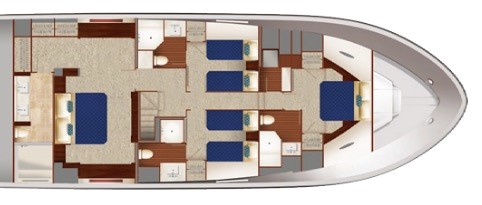

Master Stateroom
The master stateroom is full-beam which provides us with hullside windows to both port and starboard. Electrically-actuated blinds are operated by the HattCON system using iPads or the touchscreen at the door. Storage is all around, including underneath the king-size berth. Just ahead of the berth is the requisite flatscreen TV (55” /139.7 cm).

The berth is mounted slightly off of the centerline and to starboard. The reason is that to port is a pair of closets flanking, what could be considered, a dressing area. The storage under the portside window includes a vanity with a flip-up lid with a mirror underneath.

Just behind the aft bulkhead is the master head. Sensors in the ceiling detect when someone enters and subtle courtesy lights illuminate the deck so nature’s calls in the middle of the night remain safe.
The walk-in shower is at the far end of the head, and being against the hull, includes a hull-side window with the same smart glass as in the galley so it can be rendered non-see-through as desired.

Guest Staterooms
The guest staterooms are just forward in the main companionway. One is to port, the other is to starboard. And both are largely mirror images of one another. They both have a pair of single berths that can slide together to form a queen. When that occurs, the berth covers a center nightstand and another is revealed to the side.
Both have hull-side windows and plenty of storage. The one difference between the two staterooms is the heads. The port is slightly smaller than the starboard due to the fact that the atrium service bar, with refrigerator and storage, is just behind the bulkhead.



VIP Stateroom
Fully forward we have the VIP stateroom laid out much like what we would expect with an island queen, hull-side windows to port and starboard, storage closets just adjacent to the foot of the berth, additional storage is to either side of the berth and a TV mounted to the aft bulkhead.


Construction
The Hatteras M90 Panacera is undoubtedly one of the best constructed motoryachts in class. Its hull is resin-infused to achieve the optimum 60/40 glass to resin ration for maximum strength at minimum weight. Bulkheads and interior decks are also resin-infused. It has a large number of longitudinal stringers and athwartships frames and they are high, and made strong with extra laminate to minimize hull panel deflection.
No Flex Please. This approach to construction is different than many builders which rely on the natural tensile strength of the fiberglass laminate which can sustain a relatively high-degree of flex in the hull panels. Hatteras does not like hull flex because with it the interior will creak, and over time door frames and internal structures will work.

Heaviest Motoryacht in Class. At 230,000 lbs. (104,236 kg), she is most definitely in the heavyweight category, probably THE heaviest in class, despite her resin-infused hull. So, why is she from 12% to 20% heavier than other boats in class?
One of the important reasons is her low-flex policy of construction which results in a heavy structural grid in her bottom mentioned above. But there are many other reasons, here are some of them—
• Loaded with Lots of Standard Equipment. A partial list of standard equipment: stabilizers, 1800 gpd watermaker, 2x 40 kW generators, 4500 Maxwell windlass with anchor and chain, 5 ton chiller system, two hot water heaters, and powered sliding doors.
• Solid Fiberglass Hull Bottom. Hatteras doesn’t believe in cored bottoms because their relatively thin outer skin can be easily punctured by rocks or other solid objects, such as a submerged cargo container that has fallen off a ship.
• Higher Freeboard. This yacht is more like a little ship than many boats in class. Her freeboard and bulwarks are higher than virtually any boat her length. Head room on all decks is 6’6” to 7’10” (1.98 to 2.38 m) in the engine room. This means more material is used.
• Greater Beam. At 22’6” (6.86), she is the widest boat in class – 1’ to 2’ more than most. That translates into a lot of extra material -- and, more weight.
• The interior is Built In Situ. Hatteras does not build cabins and large parts of the boat outside the hull then drop them in and tape them to the hull. Rather, the bulkheads floors, decks, and structural supports are built in the boat and glassed to the hull as they go. This makes a stronger boat, but a heavier one.
• Largest Tankage Capacities in Class. She carries 3,285 gallons (12,435 L) of fuel in fiberglass tanks, 820 gallons (3,104 L) of freshwater, and her holding tank is 420 gallons (1,589 L), also in fiberglass tanks. These are not only the largest capacities in class, in the cases of the freshwater tanks and holding tanks, they’re twice the capacity, or nearly so, of some of motoryachts of her length.
• Everything is solid. Even the counters are solid granite, not honeycombed cored to make them lighter.
• Lots of little things. For example, Hatteras runs more wire on this boat because it want runs that can be accessed rather than the shortest distance. Through hulls and plumbing fixtures are beefier, doors are solid not lightweight core covered by veneer.

Innovate with the Propulsion
So, with that said, Hatteras had to innovate in order to make the M90 Panacera competitive with the performance of other motoryachts in class. It did this with a hull design that leaves a low wake and with tunnels in the hull which not only reduced the yacht’s draft to 6’2” (1.88 m), but also added thrust to the forward propulsion.
Then, Hatteras installed 8-bladed props that are 54” in diameter and have a pitch of 66” (1.67 m). These may well be the largest diameter and pitch props in class. These props were design not only to produce a high WOT speed but also to reduce vibration.
Vibration Reduction. Each time a prop blade makes a revolution it slams a body of water into the hull bottom. The mass and the velocity of the mass hitting the hull surface is one of the things that contributes to hull vibration, and hull vibration creates noise.
By having an 8-braded prop -- instead of a 4, 5, or 6-blade prop -- less mass is slammed into the hull bottom with each blade revolution, thus reducing vibration.

Performance Test
Once clear of the dock, we were on our way. We started by maneuvering through some narrow waterways that gave us a good indication of how well she handles at low speeds. Soon enough we were at open water and clear to run. Now let’s start by taking a look at the numbers.
The Hatteras M90 Panacera has a LOA of 91’9” (27.95 m), a beam of 22’6” (6.86 m) and a draft of 6’2’ (1.88 m). With an empty weight of 230,000 lbs. (104,326 kg), 90% fuel and four people onboard, we estimated our test weight at 254,236 lbs. (115,320 kg). This is one of the few times we have tested a large motoryacht with nearly a full load of fuel. Usually, builders supply them to us with a half load or less which gives them a fighting chance to hit whatever magic number has been divined.
With the pair of 1902-hp CAT C-32 ACERTs turning 54x66 pitch 8-bladed propellers in tunnels, we reached our top speed of 24.7 knots at 2315 rpm. That makes for .1 NMPG, and that number stays consistent all the way down to 1500 rpm and 10.2 knots. Below that RPM, the boat’s range starts to double, then double again, then triple.

However, for normal operations, most captains will run her at 80% load when moving the boat in a hurry. That comes in at 2100 rpm and 21.9 knots. At that speed she’ll burn 169 gph for a range of 382.6 nm -- all while still holding back a 10% reserve of the boat’s 3,285-gallon (12,435 L) total fuel capacity.
Testing at Displacement Speeds
It’s a mistake to think that a lot like this is always cruising along at 20 knots, because there many times when that is not necessary or even desirable. For example, on deliveries when time is not of the essence because the owner will not be flying in for two weeks, or when cruising up the beautiful Inside Passage in British Columbia or the Alaska panhandle.
At times like these, 1000 rpm will propel the boat at 9.6 knots, burning just 21.5 gph (81.4 lph), getting .4 nautical miles per gallon, for a for a range of 1,321 nautical miles on a load of fuel with a 10% reserve.
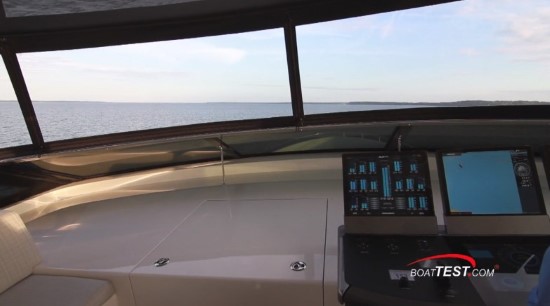
Handling
Hatteras spent a lot of time and effort into making a well performing hull so we need to test her handling, smoothness, and low sound. The first part is easy.
To test the handling, we took it from her full speed and spun the wheel hard over… and found that she’ll enter the turn at a level attitude, and then once established into the turn, she rolls a gentle 7-degrees into the turn. We could feel when the stabilizers ($63,283) kicked in and they, not so much just kept the turn docile, they also worked with the rudders to coordinate the turn, much like an airplane uses the ailerons and rudder in conjunction with one another.

As for timing, the turns aren’t quick, nor are they supposed to be. We measured our turn diameter at 600 yards (549 m) and we came around 360-degrees in 2:10 … again, at full speed.

Position Hold System
Next, because the systems are so dialed in to one another, we wanted to look at the position keeping capability of the CAT Three60 system. We stopped the boat, engaged the system and used the navigation display to zoom in to 49 yards (44.8 m) to both sides of the screen. It showed a clear picture of holding our heading as well as position. For existing conditions, we had winds to our beam at nearly 15 knots. And, of course, our Zero-Speed stabilizers were locked. Once disengage from the system, we immediately started moving at ½ knot.
Now normally this system goes through a Caterpillar interface, but what Hatteras did was work with CAT and Twin Disc to get the codes and lock that interface in with the HattCON system. So here we have it on the HattCON screen where we otherwise couldn’t if it were a Garmin, Raymarine, Simrad or whatever other display. Again… another example of HattCON being one interface.

Smooth and Quiet
Now lastly, to see how smooth and quiet this yacht is, our test captain did something he’d never normally do…he went to where the worst of the sound and vibration should be… right behind the propellers out on the swim platform.
First, he measured the sound levels, with the wind, spray and engines all going full blast. He measured between 90 and 91 dBa. We’ve measured more noise on sportboats than that.

Exhaust Fumes? Nothing but fresh air and no station wagon effect. The large mufflers with air scrubbers, underwater exhaust, and design of the stern solved these potential problems.
Inside Sound Readings. After recording 90 to 91 dBa on the transom of the boat at WOT, our captain went into the salon and measured 80 dBa at WOT (sound readings are not linear), 78 at 20 knots, and 65 at 9.6 knots. The latter number is what we record during a quiet conversation in an enclosed room.
Joystick Smarts
As for Low Speed Handling, It’s Impressive. The CAT Three60 Joystick combines the main engines with the standard 45-hp bow and optional stern ($50,090) thrusters to provide complete maneuverability around the dock and as it turns out, it’s among the most dialed-in systems we’ve seen. The reason for this is, yet again, the Hatteras penchant for making any systems better, even from third party vendors.

In this case, instead of having separate hydraulic systems for the thrusters, steering, stabilizers…etc., Hatteras instead combined all of them together and made one master system with one interface. This makes all of the functions from different vendors all work with one another since they now are all talking to each other. The result, as far as the CAT Three60 ($220,000) joystick operations are concerned, is a boat that is extremely easy to maneuver.
When we moved the joystick, the boat moves exactly in that direction. Typically, the bow or stern will have more push and we then have to compensate by turning the stick while at the same time, moving it sideways. Not so here. Move it sideways and the whole boat moves precisely as wanted.

Ground Tackle
In addition to the rail coming up 4’1” (1.25 m), Hatteras did a good job of adding a measure of safety to the working end of the bow. The ground tackle is concealed under an electric lift hatch that not only protects the area from the elements, it protects the guests from the myriad of tripping hazards associated with any area such as this.
Collectively, the ground tackle consists of a 4,500 lb. (2,041 kg) capacity Maxwell windlass hauling a 140-pound (63.50 kg) stainless steel plow anchor and 300’ (91.44 m) of acculoy hot-dipped galvanized chain. There’s a hatch so that we can access the rode, and the stainless davit is equipped with both a flip-down chain stopper and a sprayer to clean off the rode as it’s being retrieved. If a rope/chain rode is desired, a capstan can be easily added to the top of the chain stripper.


Crew Space
The crew’s quarters can be accessed from either the watertight door at the transom, or a discreet door at the portside of the aft deck. If entering from the transom, then once inside, to port is a crew stateroom with an over/under berth and the usual accommodations for storage and TV.



Directly across the companionway is the shared head. From this head, there’s another access door leading to the captain’s cabin. Here we have a queen-sized berth with plenty of storage all around. Coming out of the captain’s stateroom leads us to a small central seating area with a two-across bench seat opposite a flat screen TV.

Crew Galley
Just to the port of the crew’s seating area, is a modest galley with an over-the-counter microwave and plenty of counter space. Below are refrigerated drawers, then a single basin stainless sink with storage above and below. And then, of course, there are the curving steps to the aft deck.

Engine Room
The engine room is accessed from the forward end of the crew quarters. Just outside the door is an electrical panel with 6 separate distribution switches to direct the power from the two 40 kW generators, shore 1, shore 2, or off. And we’re happy to see that switching from any one power source to another requires going through an “off” setting first so surges are not a factor.


Upon entering the engine room we were greeted with a welcome work area. The overhead measured 6’8" (2.03 m) right at the doorway, and when we continued ahead, we stepped down and the headroom increased to 7’10” (2.39 m).
At waist height, we measured 28” (71 cm) at the narrowest point between the six fuel filters. To either side of the entrance are the twin 40 kW generators, and of course the main focal point of the engine room are the twin Cat C-32 ACERTs at 1902-hp each ($315,000 upgrade cost from the standard 1600-hp CATs).


Engine Room Equipment
Naturally the engine room has the usual cast of characters expected in a boat of this class… air scrubbers, massive (5 ton) chilled water air conditioning system, twin 40 kW generators, three high capacity Racors on each engine, two water heaters (50 and 30 gallons), etc. But, there are two standouts as standard equipment, in our opinion.
The 1,800-gallon/day (6,814 L/day) water maker from Dometic is first. Never being ones to be satisfied with a stock system, Hatteras decided to work with Dometic and incorporated a significant upgrade to this system. Watermakers lose their prime easily. It’s just the mature of the beast. All it takes is a roll or backing down causing bubbles to go under the boat. Then the alarm goes off and you have to go down and re-prime the system to get it taking in water again. Well here, in essence, the two companies’ (Dometic and Hatteras) engineers created a programmable logic controller (PLC) to solve the problem.

The Solution. What Hatteras told Dometic it wanted was when the water maker loses its prime and the high-pressure pump quits, to flush out the head of the pump every time it lost its prime. If you flush the boost pump, it’s going to self-prime itself.
The system keeps doing this until it builds its pressure on the high pressure side, and will do it up to three times each time it loses its prime. If it doesn’t re-prime after the three attempts, then, and only then will it remain in shut down mode and signal the alarm for a manual re-prime.
Since the application of this engineered system, Hatteras has never had to manually re-prime a water maker.

Then we Come to the Exhaust System. Hatteras wanted to ensure that this boat was the quietest, cleanest and least obtrusive yacht available. To that end, the exhaust system starts with huge risers that are high enough to provide the necessary back pressure to the system while still eliminating the backflow from being down below the waterline.
From there the system feeds into massive muffler systems that quiets the output and incorporates soot scrubbers into the system. This means that we don’t smell diesel exhaust. Because of the boat’s design and outlet placement, we avoid the station wagon effect of having the exhaust come back over the swim platform and onto the aft deck. We checked this -- no fumes.
Finally, the exhaust is directed into the water. The result is a quiet ride that at cruise peaked at 90 to 93-dBa from the swim platform at full speed with no diesel-y smell. This will be the friendliest boat at the anchorage.
This exhaust system also has the advantage of running low under the crew deck, so Hatteras was able to provide the M90 Panacera with a full beam crew quarters.
Fuel Fill
It seems amazing that we have a section dedicated to a fuel fill, but here it is. On our test boat, the fill was on the port side, but it can be on either, or both. It resides behind a hatch about midway up the side deck and against the cabin side.

It starts with the patented vents on top that we can hang a small bucket on to catch any run off, but the likelihood of that happening is slim to none. Here’s why…
In the center of the two fill inlets is a digital gauge that shows the progress of the fill process for each tank. Once it gets to 90% it gives an audible alert signaling that we should slow down the, typically high-speed, nozzle. Once it gets closer to 100%, we can stop the pump.
HattCON at The Pump. Of course this is made even easier by HattConn. That means that not only is the process monitored by the HattCON screens on the iPad mini’s, it’s also repeated on your smartphone, so we can be watching right at the pump on the dock, not only at the side deck where the gauges are.

Pricing
The Hatteras M90 Panacera has a base price of $8,995,000, with nearly everything most people need as standard.
All in, we were at $10,452,799 for the boat we tested. The most expensive options were the upgraded horsepower on the CAT engines ($315,000), the fold-down balcony ($239,000), the CAT Three60 joystick ($220,000), the hydraulic swim platform ($178,816), a premium AV system ($163,630), and teak decking on the flying bridge and boat deck ($108,233).

Observations
There are a number of 90’ (27 m) motoryachts on the market, and many of them are less expensive than the M90 Panacera. We advise that owners who just want to drive the ditch north and south and have some big parties aboard tied up at the dock or cruising the harbor to save their money. There are some perfectly good boats on the market for that purpose, for less money.
However, for discerning owners who want to take a 90-footer virtually anywhere in the world and not have to worry much about weather, or taking green water over the bow, or gremlins in the yacht’s systems, and not have to worry about how the boat was put together or measure taken to save weight or money, then this yacht should be at the top of one’s short list.
When we asked one of the Hatteras engineers why the boat was so heavy compared to others on the market, he answered, “What did they leave out?”
Semi-Custom. Remember that when buying any yacht in this price range, the builder is usually more than happy to change many things about the boat to suit, except structural bulkheads and a few other obvious things. On the M90 Panacera, Hatteras is able to provide any numbers of alternative layouts. There is a lot to work with here because the structure of the vessel is so remarkable.
Finally, Hatteras has always excelled at installing systems that are reliable and durable for the long haul. Several of its engineers and department heads have been at Hatteras for over 40 years. They have been building motoryachts longer than most motoryacht builders have been in business. They know a thing or two, because they’ve seen a thing or two. It is that depth of knowledge that has gone into the 90 Panacera and what has made it an impressive yacht.



